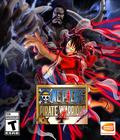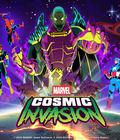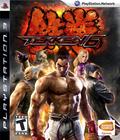With Tekken 6, the system-defining fighting game of two console generations has finally made the jump to high definition, but it seems to be missing a few elements that are key to keeping it attractive to fighting game fans.
The basics of Tekken are pretty similar to what they've been for the past 15 years, but somehow, it's more confusing than before. From a summary of the entire plot in a 2-D moving-objects style to the introductory chapter, it's safe to say that it would require a pretty hardcore plot fan to figure out what's going on. In short, Jin Kazama managed to kick the butt of Heihachi Mishima — and thus take over the Mishima Corporation. Corporate takeover by beating up the current CEO doesn't seem to be the smartest organizational method, but then again, this is Heihachi, a fellow who, when pulled into the past, was more concerned with kicking people's butts to find a challenge than getting home. Now Jin is either in progress of taking over the entire world with Mishima's resources or has already done so. Heihachi, apparently, had one hell of a private army in the Tekken Force.
Fortunately, some of said forces grew disaffected and turned on their corporate masters, so Mishima has a rival in the mysterious G Corporation. All the while, something Heihachi saw at some ruins in Central America warns of an impending apocalypse.
The game's Scenario mode casts you as Lars, a fellow who was with one of the rebellious Tekken Force divisions until, while raiding an old Mishima lab, he managed to be hit by an exploding Jack (android fighter) and lost most of his memory. Surprisingly, this is actually treated fairly realistically, with it being stated that he probably won't get his full memory back. Lars gets little clues when he sees certain things and has to guess from there. A little more confusing is how the robot-like girl in the weird cryochamber next to Lars knew his name when he didn't. She finds it weird that he's able to equip items, but she chooses to go off with him to figure out what's going on. All the while, every other wheel the game cares to bring up is rolling at the same time, and a giant wooden doll gets up and decides to go save the world. No, I'm not making that last bit up, and Mokujin is still the best thing in Tekken.
The gameplay in the Scenario mode is where the troubles begin. Arcade fighter systems usually don't port very well to open brawlers. This was true when Namco did this back on the PS1 in Tekken 3, and it's true now, over a decade later. The exact same controls that are wonderfully intuitive in the arcade context become massively frustrating when you're dealing with unintended camera angles, making basic combos nearly impossible and producing a slogging brawler outpaced by World of Warcraft. You'll eventually get used to this mode, but it still ends up being unbelievably slow and is only exciting because of an MMO-like gear-drop mechanic.
Fortunately, the game lets you unlock the ability to play as any character in any scenario — after fighting them in Scenario mode — and it avoids ludicrous gimmick fights during the levels. Further, players who choose to persist with this mode can pick up a pretty wide variety of items to change character costumes. This isn't as involved as Soul Calibur IV's depth of customization, though. It adds up to three to five items, each in 15 color variants, for each character, all keeping rather tightly to that character's theme.
I've gone on for 600 words and haven't even gotten to the actual Fighter mode, which is normally the core of these games. The gameplay is slower than any Tekken I've played before, which appears to be an error of some sort. Amidst the cast of 40 characters, the few new characters go completely unrealized until the Scenario mode. The Arcade mode, the default fighting game mode, isn't even in the main menu; it's hidden behind the Offline Modes option.
Once you take off the nostalgic glasses, the fighting doesn't hold up as well as it used to. Its sheer slowness even makes it frustrating to build short combos, in spite of characters being quite nicely varied in their play styles and subtleties. In a genre that is only getting faster and easier to get into, Tekken 6 comes across as a monolith of a generation ago, when it had Guilty Gear and indie fighters as its only competition. Namco Bandai has already shown that it's not resting on its laurels since it fixed a few issues to make Soul Calibur IV a fun, accessible fighting title. Why, then, does Tekken 6 remain so ploddingly slow and unintuitive?
It also doesn't help matters that the Tekken 6 online experience is among the worst that I've encountered. Keep in mind that I live in the boonies so I rarely get solid online experiences from consoles, but I came upon more hiccups, disconnections and general unplayability than usual. I'm not alone, either, as these issues have shown up nationwide, and Namco Bandai has released a patch to address some of the data transmission issues. If you want to seriously compete in this game, you may have to resign yourself to practicing locally or using ghost data.
Tekken 6 has a few saving graces, such as the aforementioned ghost data, which you'll also encounter in the Arcade mode — assuming you manage to locate the Arcade mode in the first place. Your play style is constantly being analyzed by the game, and while a ghost based on you won't be perfectly like you, it makes a pretty good representation. You can then send the ghost data to other players and, in turn, receive it from others. You can dissect combos here, but unfortunately, it's also where depth issues became clear, as most of the ghost data I fought played similarly, even though they supposedly represented stronger players as I fought further in.
More significant is Tekken 6's jump to high definition. Animations are now silky-smooth, and characters, while not precisely realistic, are quite beautifully detailed. Sounds are nicely punchy, the music manages to keep a solid tone (even if it's not particularly memorable), and the voices are pretty spot-on. The game's stat-keeping is also a standard-setter that more games across the entire fighting game genre need to match.
It's unfortunate that these few saving graces can't help the game beyond the plodding and unintuitive fighting, the even more unintuitive Brawler mode that represents a majority of the core gameplay, and a truly painful online experience. This is all wrapped up in a package that also suffers from maddening load times, even if you install the game to your hard drive. Gamers who love 3-D fighters are better served by the much more accessible Soul Calibur IV, while the hardcore may as well jump to BlazBlue or wait for Super Street Fighter IV, both of which have proven to be superior technical fighters. In spite of a beautiful HD update, Tekken 6 on the PS3 just doesn't hold up as well.
Score: 6.0/10
More articles about Tekken 6










 Tekken 6 sees the return of many familiar faces as well as new characters to create the largest line-up the series has ever seen. With a growing roster of fighters, each equipped with their own deadly techniques, moves and attack combinations, Tekken 6 will be the best King of Iron Fist Tournament yet. Adding to the already rich gaming experience, a deeper character customization feature will only further enhance the incredible fighting intensity as players go mano-y-mano. Players can also take the battle online for classic match-ups and to compete for world domination.
Tekken 6 sees the return of many familiar faces as well as new characters to create the largest line-up the series has ever seen. With a growing roster of fighters, each equipped with their own deadly techniques, moves and attack combinations, Tekken 6 will be the best King of Iron Fist Tournament yet. Adding to the already rich gaming experience, a deeper character customization feature will only further enhance the incredible fighting intensity as players go mano-y-mano. Players can also take the battle online for classic match-ups and to compete for world domination.


































